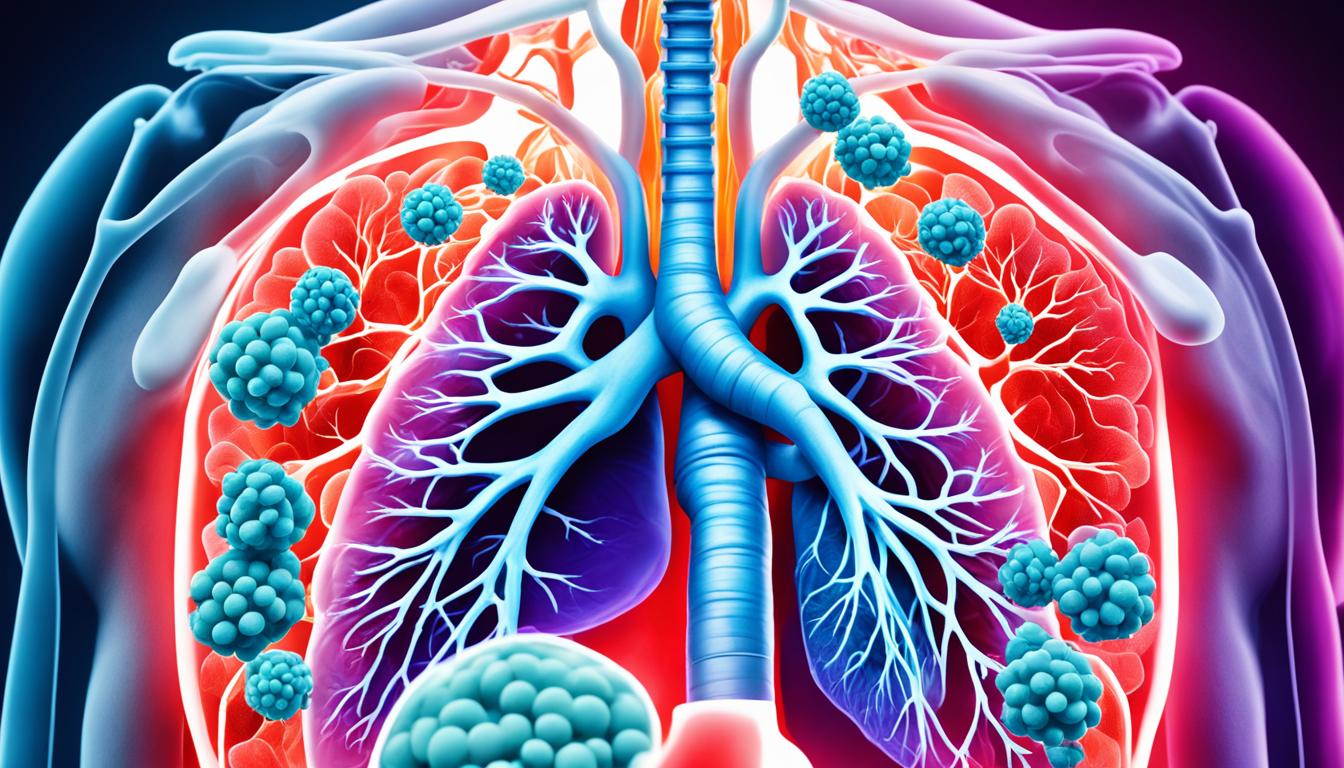Pulmonary problems after a stem cell transplant are serious and can even cause death. These issues might be due to infections or not. They often happen at different times after the transplant.
The main noninfectious reasons for these problems are the drugs used for preparation, issues with the tissue type, how the donated cells were handled, and a bad reaction of the body against the transplant. On the other hand, infections can come from many sources, such as bacteria, viruses, fungi, and single-celled organisms.
It’s important to try to prevent these lung problems, find them early, and treat them fast. This approach is key to helping those who have had a transplant.
Key Takeaways:
- Pulmonary complications after allogeneic hematopoietic stem cell transplantation (HSCT) can be infectious or noninfectious.
- Noninfectious causes include conditioning regimen, HLA histoincompatibility, graft manipulation, and graft-versus-host disease (GvHD).
- Infectious etiologies can include bacterial, viral, fungal, and protozoan pathogens.
- Prevention, early detection, and intervention are essential in managing pulmonary complications after HSCT.
- Further research and clinical trials are needed to explore the potential of stem cell therapy in treating pulmonary complications after HSCT.
Pulmonary Complications Timeline After Hematopoietic Stem Cell Transplantation
Pulmonary problems can happen at any point during the stem cell transplant process. They fall under infectious or noninfectious types. Each type has its own causes and symptoms effects related to lungs over time after the transplant.
Pre-engraftment Period (0-30 days post-HSCT)
In the first 30 days after the transplant, patients might face noninfectious issues. These include things like lung fluid buildup, chest fluid gathering, engraftment issues, and lung problems. Lung fluid buildup can cause shortness of breath, coughing, and wheezing.
Chest fluid gathering leads to chest pain and tough breathing. Engraftment problems might show as fever, rash, and lung issues like cough and pain. Lung issues can also be triggered by treatment, histoincompatibility, or the transplant process itself. This causes lung function problems and breathing issues.
Early Post-engraftment Period (31-100 days)
From 31 to 100 days post-transplant, patient immunity is low, and lung injuries might be delayed. This increases the risk for lung infections and other lung issues. Conditions and the use of certain drugs play a part in these problems.
Late Post-engraftment Period (Beyond 100 days)
After 100 days, lung complications could be due to slow immune recovery, drug side effects, and graft-versus-host disease (GvHD). GvHD happens when donor cells attack the patient. This can cause coughing, short breath, and chest pain.
Infections might continue in every period, especially when the immune system is weak or drugs are still being used.
Early detection and treatment are key to handling lung problems after a transplant. Keeping a close eye on symptoms and working together as a healthcare team is vital for patient care.
| Pulmonary Complication | Symptoms |
|---|---|
| Pulmonary Edema | Shortness of breath, coughing, wheezing |
| Pleural Effusion | Chest pain, difficulty breathing |
| Engraftment Syndrome | Fever, skin rash, cough, chest pain |
| Lung Injury | Inflammation, impaired lung function, respiratory distress |
| Infectious Complications | Fever, cough, shortness of breath |
| Chronic Graft-versus-Host Disease | Cough, shortness of breath, chest pain |
Noninfectious Pulmonary Complications After Hematopoietic Stem Cell Transplantation
After a hematopoietic stem cell transplant, noninfectious pulmonary issues can be big for patients. These can include things like pulmonary pneumonia and lung injury. They happen because of different things, like the treatment method used and the body’s reactions to new cells.
Patients might feel feverish, find it hard to breathe, cough a lot, or lack oxygen. Recognizing these symptoms early is key. It helps stop more problems and makes patient outcomes better.
The table shows common noninfectious pulmonary issues after a transplant and what causes them:
| Complication | Associated Factors |
|---|---|
| Pulmonary Pneumonia | Conditioning regimen, histoincompatibility |
| Pulmonary Edema | Conditioning regimen, graft manipulation |
| Diffuse Alveolar Hemorrhage | Graft-versus-host disease, histoincompatibility |
| Pleural Effusion | Graft-versus-host disease, conditioning regimen |
| Lung Injury | Conditioning regimen, graft manipulation |
It’s very important to manage these issues well and act early. This ensures problems are found and treated quickly. Doctors should check patients’ breathing carefully and treat any issues fast.
Conclusion
After a stem cell transplant, lung issues, like pulmonary edema, are a big worry. It’s crucial to find ways to manage and prevent these problems. This helps reduce suffering and saves lives.
Stem cell therapy offers new hope for those with lung issues after a transplant. It can repair lung damage and adjust the body’s immune system. This could mean better recovery for patients with pulmonary edema.
But, we need more studies and tests to be sure stem cell therapy is both effective and safe for lung problems post-transplant. Learning more will let us create treatments that meet each patient’s unique needs. This could significantly improve their well-being.

